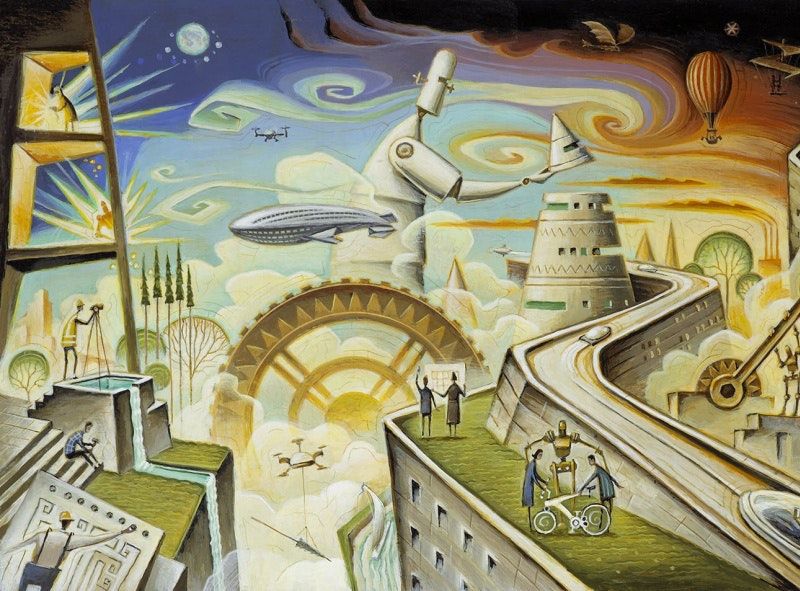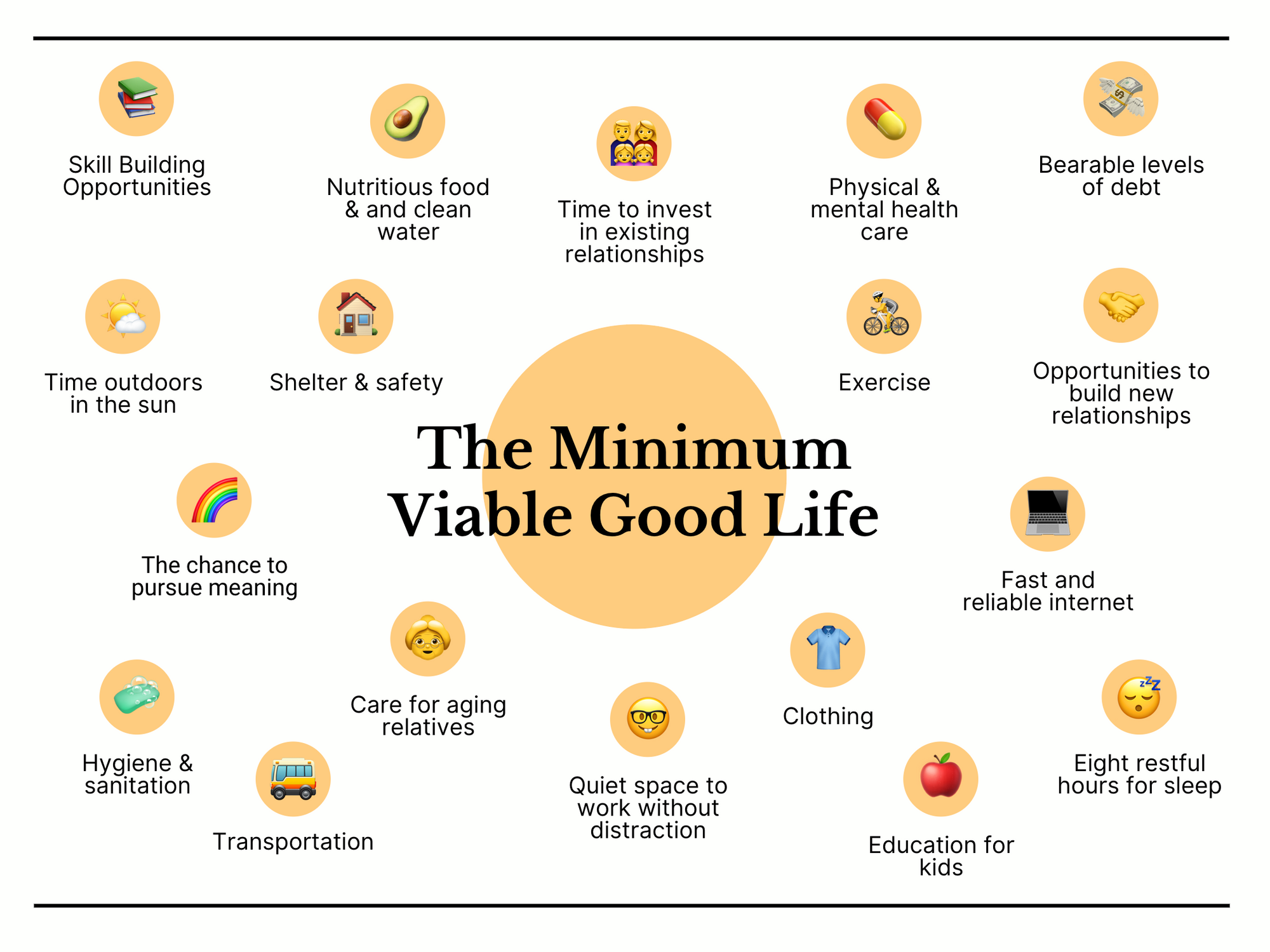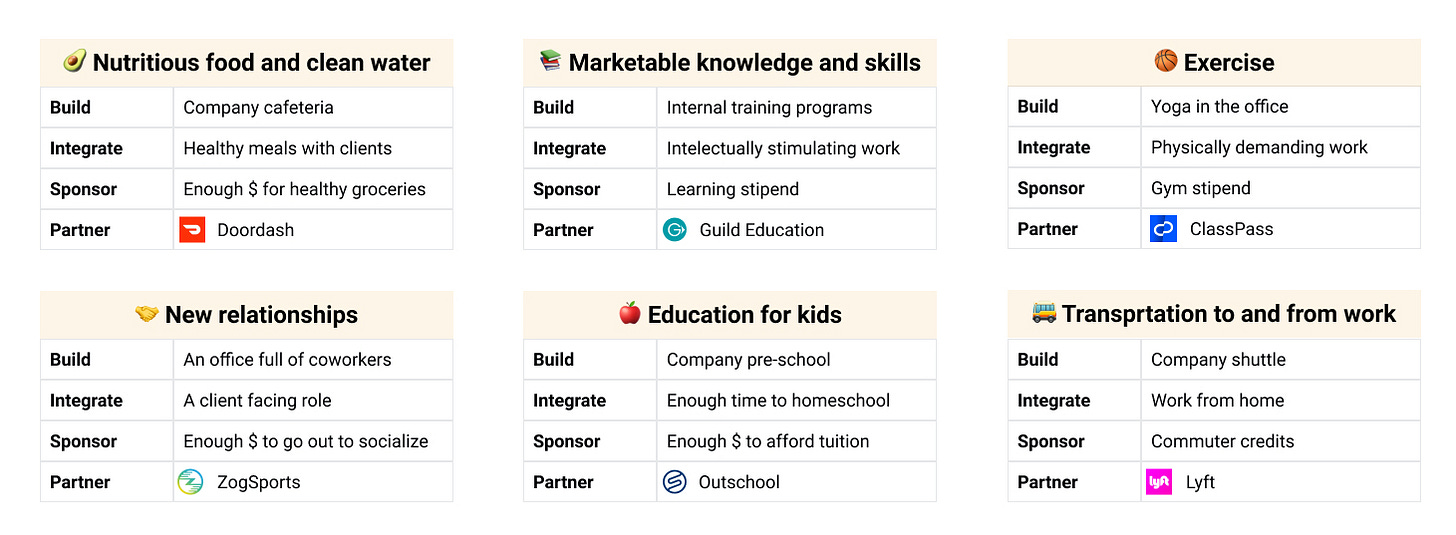The Minimum Viable Good Life
Building a future of work that promotes human flourishing

Let me tell you a story about the future of work.
You wake up on a Monday in September. After fixing yourself a cup of tea, you step out your back door and make your way into the woods. After a few hundred yards, you come upon a wooden structure with one wall made of glass.

You slip inside and sit down at your desk. Like always, the first few hours of the day are yours to focus on whatever's most important.
As you dive into your work, there are no pings, bings, or buzzes.
No calendar appointments.
No Slack messages.
No emails.
This time is entirely yours; co-workers appreciate how important mornings are for uninterrupted focus.
A few hours later, you head back to the house where your spouse is serving lunch. You sit down at the picnic table beside your two kids, across from another family who lives in the house next door. You help yourself to some salad. The veggies are fresher than anything you used to eat when you lived in the city.
After cleaning up lunch, everyone puts on running clothes and heads off for a quick jog through the woods. As you arrive at the lake, everyone stops to take a quick cold plunge. When you return home, the kids return to their schooling pod while the adults head back to work.
You slip back into your office for a collaborative working session with two junior designers on your team. While the output of the project is important to the company, it's been scoped for training, so you're in no rush to submit a deliverable. You run the session like a class, letting them try their hand at the prompt before offering feedback.

You take your last few meetings by phone on a walk through the woods. As you arrive back in your yard, you find your spouse, kids, and three other families sitting around the fire. You help yourself to some dinner and take a seat beside them.

Your spouse breaks out a guitar, and everyone sings along to bad 90s songs until the kids are ready for bed. Not long after you put your kids to sleep, you and your spouse retire to the bedroom for a good night's rest.
A Fulfilling Future of Work
For most of recent history, work constrained how we live. It influenced where we slept, who we spent time with, and how our days were structured. But as work begins to uncouple from location, we have a rare opportunity to reimagine our collective future.
What if this time around, instead of planning our lives around work, we designed work to help us lead more fulfilling lives?
To explore this question, we will need to construct a shared templater for a fulfilling life. While the definition of a good life is a heavily debated topic across many academic fields, that doesn't mean we should feel too intimidated to weigh in.
What follows are 18 elements that I believe are necessary to allow people to build satisfying and prosperous lives. This list isn't meant to be comprehensive of everything a person might want. There's no Tesla. No trip to Tulum. No iPhone 12. Rather, once all the needs below are filled, most people should have the resources to build a life they want. For simplicity's sake, let's call this set of 18 elements: The Minimum Viable Good Life (The MVGL).

Delivering the Good Life
Perhaps you're wondering whether employers can and should offer all these things as benefits to their employees.
I wouldn't recommend it.
However, employers should take an interest in ensuring their employees can check the boxes of the MVGL. Why?
The output workers create drives the revenue that keeps their companies alive and growing. Since workers' outputs are a function of their inputs, employers should want to ensure their workers to get what they need to perform at a high level.
To deliver the elements of the MVGL to their employees, companies can use several strategies, including:
- Building shared resources at a company level.
- Integrating them into the day to day responsibilities of job roles
- Sponsoring employees to acquire them on their own (by increasing compensation)
- Partnering with another organization to provide them
It's possible to take different approaches to each element. For example, take my employer, Guild (we're hiring!):
- Guild built a daycare solution for its workers.
- Due to the company's mission, Guild has been able to integrate the chance to pursue meaning within employees' job responsibilities.
- Guild sponsors exercise by offering a monthly stipend.
- The company partners with Modern Health to deliver mental health services.
The following tables show how a company could employ any of these strategies to help fulfill different elements of the MVGL:

Let's Get Prescriptive
With that context in place, let's explore how companies might integrate the MVGL into their employee experience:
Step 1: Survey your employees
Find out how your people are spending their time. How many minutes each week do they spend exercising? How often do they talk to their five closest friends? Do they worry about debt a lot? This data can offer valuable insight on which needs your employees are and are not able to satisfy.
It's also useful to gather insight into how employees feel about their lives. Are they getting energy from work? What's keeping them up at night? What gets them out of bed in the morning?
Allowing employees to anonymize their answers will drive up participation. But, ideally, you'll want to perform follow up interviews to understand the root causes of the challenges employees are facing.
Step 2: Prioritize areas to address
Using the aggregated survey results, rank each area of the MVGL on the following dimensions:
- Fulfillment – which elements of the MVGL is your workforce having the most trouble satisfying?
- Sentiment – which unsatisfied needs are creating the largest negative impact on employees' lives? Which ones, if solved, would make the biggest positive impact?
- Brand Risk – which needs, if left unfilled, are most embarrassing for the company (for example, it would be embarrassing for the press to learn that the employees of a health food company don't have access to nutritious food)
Step 3: Brainstorm high leverage interventions
Some interventions can satisfy multiple needs at once.
For example, transitioning employees to remote work can give them the flexibility to:
- Invest in relationships with family members
- Get the sleep they need
- Shop for and cook nutritious meals
Offering employees an across-the-board-raise can help them afford:
- Better education for their kids
- Care for their aging relatives
- A safer and quieter place to sleep and work
As you're brainstorming interventions, think back to the four strategies that companies can use to fulfill the elements of the MVGL.
Step 4: Prototype and test solutions with small groups of employees
Before rolling interventions out to the entire company, test them on smaller groups of employees. Ideally, look for groups who desperately want to solve the problem that your intervention is designed for, as they'll be more forgiving about initial road bumps.
The interventions you choose to test should specifically fit the needs of those in your ideal employee profile. For example, if it's mission-critical for your company to attract and maintain a larger junior salesforce, you may want to prioritize interventions that allow your employees to socialize and build bonds with one another. If your most valuable employees tend to be older and have families, you may want to focus on interventions that give employees maximum flexibility to serve as caretakers.
A Conversation Starter
There are, of course, lots of questions that remain unanswered, including:
- How can we ensure that people aren't entirely dependent on their employers to fill all these needs?
- Which parts of the MVGL should we depend on the government to deliver?
- How can small businesses that can't afford to offer the full MVGL still support their workers?
This essay doesn't offer all the answers. But I hope it will inspire some useful conversations between HR departments and their employees about ways to partner and create a better future of work.
Back to the Future of Work
As you lay your head on the pillow, after kissing your spouse good night, you take a moment for gratitude. Who'd have ever thought you'd find work that enabled you to raise your kids in such a tight-knit community or nourish your body with food grown in your own backyard?
While life isn't perfect, you feel so much more authorship of it. Thinking back to the way you used to live, all those years ago, you can't help but appreciate your work and the life it's enabled you to live.
Thanks to the folks at Compound like Dan, Drew, Patrick, Rob, and Tom for their thoughtful edits. As well as Ashley and Justin, for their valuable feedback.
